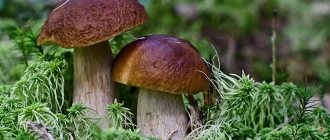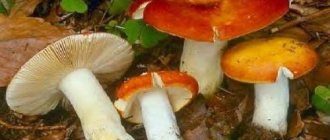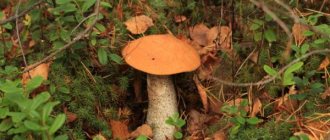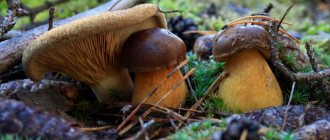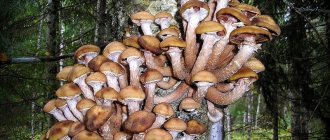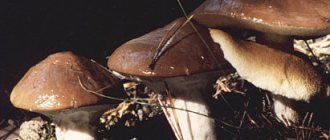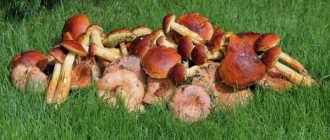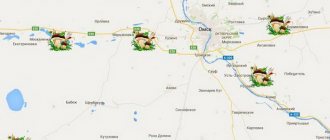Being a mushroom picker is quite an interesting hobby, which involves a forest adventure and walks in the fresh air. But in order for this activity not to cause harm, you need to have a good understanding of mushrooms in order to easily identify edible ones.
There are a huge number of edible species. They have a special aroma and taste. Many of the representatives are considered delicacies, and finding them is a great success.
Mushrooms allowed for consumption are divided into classes, taking into account their taste and nutritional value. Many are incredibly valuable due to the large amount of nutrients they contain.
Mushroom “meat” requires the presence of useful substances such as proteins, carbohydrates, and is also rich in vitamins and minerals. It also contains enzymes that affect the digestibility and functioning of the digestive system. Champignons, which are considered the most consumed by humans, exhibit especially good properties.
Clustering of edible mushrooms implies the presence of the rarest specimens, which are not so easy to find. Finding a rare mushroom that has little nutritional value is still considered a great joy for mushroom hunters.
Here you can see a list of the most famous edible mushrooms that are of particular value to mushroom pickers. However, it is necessary to clearly know the distinctive features of the species so as not to confuse them with inedible ones.
Polish mushroom
Belongs to the boletus species. Previously, it was imported to Russian markets from Poland. This is where the name came from. It is considered a valuable product. It is boiled, fried, dried.
Appearance similar to porcini mushroom. At the beginning of growth, the cap is wrapped. It unfolds when the wearer grows to approximately 12 cm.
Rarely found in nature. Grows in acidic soils in areas with coniferous forests. Loves beech, oak and chestnut. Found in lowlands, foothills, and at the foot of trees.
Autumn honey fungus
Can be used in any form. The structure of the product is dense (it needs to be boiled for a long time) with a pronounced mushroom aroma, but it’s not for everyone.
The cap is first convex, then expanded, 2–15 cm in diameter. The color is sandy-orange, brown. Towards the center the color becomes brighter. There are small scales along the edges. The pulp is whitish.
Autumn honey fungus is a parasitic mushroom. It grows in a friendly family on trees and stumps. Prefers mixed forests consisting of birches, aspens, oaks and pines.
Edible raincoat
Edible mushroom from the champignon genus. Suitable for any culinary dishes. It has a pronounced mushroom taste. The mushroom is collected at the beginning of its growth. As it grows, it becomes very tough.
The color of the mushroom is light, almost white. Has brown inclusions (scales). As they approach the center of the cap, the scales become darker. The fruit part is 2–5 cm in diameter.
Grows in coniferous and mixed forests. Prefers wet (rainy) weather. Ripening time: early summer / late autumn.
Ringed cap
It is predominantly distributed in Europe. He has many poisonous counterparts. Grows from July to September in damp forest areas. More often found near blackberry bushes and under spruce trees.
The mushroom's cap is similar to a cap, up to 12 cm in size. The color ranges from a yellowish tint to brown. When cut, white flesh is visible. When exposed to oxygen, it quickly turns yellow.
Kozlyak
An edible representative of the boletus genus. It is also called reshetnik, flywheel. Delicious, slightly slippery mushroom. It is easy to confuse the goat mushroom with its inedible brother, the pepper mushroom.
The cap is 3–12 cm, cushion-shaped, spongy, porous, shiny. It feels sticky and smooth to the touch. Color - light brown, brown.
Loves coniferous forests and acidic soils. Often grows in symbiosis with pine. There are single “tenants” and entire families.
Porcini
One of the most valuable noble mushrooms. Other names: boletus, yolk. The mushroom is edible in any form. It has a rich, dense taste.
The stem of the mushroom is thick, dense, and beige-white in color. The cap is brown, straightened, up to 50 cm in diameter.
Peak collection occurs in late spring and early summer. But it is also found in the fall (in warm, humid weather). Loves deciduous and coniferous forests, often growing near moss and lichen. Prefers loamy soil and sandstones. Distributed throughout Russia.
Common dubovik
An edible type of boletus. Valuable mushroom. Similar in appearance to its white counterpart. Grows mainly in oak forests. Sometimes found in coniferous and mixed forests.
Oak wood is collected throughout the summer and early autumn. The best time is after the rain. The cap of the mushroom is large - up to 20 cm, and shaped like a dome. When it grows, it opens up and becomes like a pillow. The surface is matte, velvety. Color - gray-brown.
Does not lose elasticity during cooking. Has a delicate mushroom aroma.
Bruise
Edible but unusual mushroom. In appearance it is beige, but when pressed or cut it begins to acquire a bright blue color. The blue substance secreted by the fungus is safe for humans.
The cap is convex, evenly colored in a sandy shade. There is a thickening on the bottom of the leg. The pulp is brittle and loose.
Grows alone in sandy soil. Loves oak groves or conifers. The collection begins in mid-summer and continues until the end of the warm season. The representative is listed in the Red Book.
boletus
A beautiful, edible mushroom. Has a pronounced mushroom aroma. Suitable for any dish.
The lumpy, matte cap is represented by a hemisphere with a diameter of 5–15 cm. The color is gray-light brown, darkening towards the center. May be confused with gall fungus. It is not poisonous, but very bitter.
Boletus mushrooms are collected near deciduous trees. They grow on the edges and in lowlands.
Gray row
An edible mushroom with a bright taste. It has other names - serushka, pine tree. It is eaten after heat treatment (after boiling). Dense mushroom base without bitterness.
Grows in symbiosis with pine trees. Loves sandy soil under pine and mixed forests. Does not disdain old plantings.
The hat is average - 4–12 cm. Sometimes it grows up to 20 cm. Color - gray with a slight purple tint.
Common chanterelle
Edible bright orange mushroom. It is also called “cockerel”. Difficult to confuse with other specimens. Initially, the cap has a slight convexity, then becomes irregular in shape and curls into a funnel. Diameter - 4–7 cm.
The taste is mushroom, dense. The consistency of the fruiting body is fleshy and compacted. During heat treatment, it loses a little color, but retains moisture.
It grows in groups from June to November in coniferous and mixed forests. Often found near moss and in needles.
Lilac-legged rower
An edible mushroom from the row family. They are among the good mushrooms, that is, they are collected and eaten. The mushroom got its name because of the corresponding color of its stem.
The cap is white with a slight purple tint (6–15 cm), the leg is purple. Sometimes there are giants up to 25 cm.
A meaty, dense mushroom. The taste is sweetish, with fruity notes. No strong mushroom taste. Grows in summer and autumn in meadows and forests.
Oiler yellow-brown
Tubular, edible representative of butter. Other names: swamp grass, pestle. Prefers symbiosis with pine, but is also found in mixed forests. Grows on sandstone and among fallen pine needles.
The cap is small - 3–10 cm in diameter. Flat shape. Color - brown-cream.
The mushroom is fried, boiled, marinated and salted. The quality of the product is low, but many value it for its specific, oily taste.
Golden scale
A bright, easily recognizable mushroom. Grows in groups. Loves living but fallen trees.
Conditionally edible mushroom. It has an incomparable, slightly sweet taste. Experienced mushroom pickers collect it, heat it and eat it. However, many people complain of stomach pain after consuming the product.
The hat is shiny. It is bright orange with dark spots. The shape resembles a convex bell. Diameter - 5–10 cm.
Yellow hedgehog
Often called the chanterelle's cousin. Has high taste qualities. Easy to prepare - no need to boil or soak.
Mushroom specimens are reddish in color with a wavy cap up to 15 cm in diameter. There are small spines under the cap.
The representative grows in humid forests (mixed, deciduous, coniferous). Prefers to grow in groups.
Variegated umbrella
Edible, very tasty mushroom. But only experienced mushroom pickers collect it, as it can be confused with its poisonous counterparts - fly agarics.
The cap is initially ovoid, but as it grows it opens up and becomes huge. Some specimens grow up to 50 cm.
Grows on lawns, forest edges, paths. Loves oaks, pines and other coniferous trees.
Amanita pearl
An edible mushroom distributed throughout the northern hemisphere. Collection occurs from spring to late autumn. There are single specimens, but more often the mushrooms settle in groups. Loves clearings and light areas in mixed forests.
The cap is 5–15 cm, yellowish-cream, brighter in the center. The pulp is brittle (turns pink when cut, then turns red), without much taste. The mushroom aroma is subtle.
Green moss
Famous edible mushroom. Grows under broad-leaved trees (likes birch and willow). Moss mushrooms are harvested in the autumn - from August to November.
The hat is brown (up to 8 cm), matte. The leg is yellowish or greenish. The sponginess is porous, yellow.
Volnushka white
Conditionally edible, not very tasty mushroom. Commonly called whitefish. Accordingly, it has a white color and furry scales on the cap (its diameter is up to 6 cm). When cooking, the volushka is soaked and boiled several times.
The mushroom grows next to birch trees. The representative is most often collected by Russian mushroom pickers. In Europe it is ignored.
Description of edible mushrooms with photographs
This description is primarily intended to answer your popular queries about mushrooms: where to collect them, what time of year, what edible mushrooms look like, detailed descriptions with photographs, whether they can be grown at home, what is best to prepare, poisonous and inedible counterparts.
The catalog includes most of the known edible and conditionally edible mushrooms growing on the territory of the Russian Federation. Each description is complemented by an illustrated picture or photograph taken in their natural habitat. In addition, for a complete picture of a particular mushroom, the descriptions are supplemented with excerpts from books, authoritative magazines, reference books and video reviews.
We didn’t find a mushroom here, perhaps it is poisonous or inedible, or it is not yet described on the site and we will be happy to help you identify it.
The forest areas of Russia are very rich in mushrooms, and residents do not miss the opportunity to take advantage of this gift of nature. Traditionally, they are fried, pickled or dried. But the danger lies in the fact that many poisonous species skillfully disguise themselves as edible mushrooms. This is why it is important to know the characteristics of the varieties that are approved for consumption.
The best areas of Donbass for mushroom picking
If you have experience, but no knowledge of the area, then you should go along the paths trodden by local mushroom pickers, since the favorable climate contributes to the constant fruiting of myceliums and the intensive growth of mushrooms, allowing no one to be left without a catch.
On a note!
Thus, the forests of Slavkurort, located near such villages and cities as Svyatogorsk, Shchurovo, Krasny Liman, Blagodatnoye, are rightfully considered the most mushroom place in the region.
You may be interested in: How do edible talkers differ from false mushrooms? How many days after rain do mushrooms grow? Bitter mushroom: photo and detailed description
All these coniferous beauties can be found in the north of the Donetsk region, but if you move south, towards Mariupol, you can find another pearl, this time deciduous and mixed, called the Velikoanadolsky forest, which is near Volnovakha. And if near Slavyansk you can find a lot of porcini mushrooms and boletus mushrooms, then here there is a real treasure trove of boletus, boletus and chanterelle mushrooms.
There are also small forests and plantings in the Donbass, which also boast an abundance of various mushrooms. But you should collect them with caution, remembering that nearby highways, industrial enterprises, settling tanks and landfills do not have the best effect on the quality of mushrooms, which tend to absorb harmful substances like a sponge.
How to distinguish edible species
Mushrooms are not only tasty, but also very healthy food. They contain substances such as salts, glycogen, carbohydrates, as well as vitamins of groups A, B, C, D. If the mushrooms are young, then they also contain many microelements: calcium, zinc, iron, iodine. Their intake has a beneficial effect on the body's metabolic processes, increasing appetite, functioning of the nervous system and gastrointestinal tract.
Forest edible mushrooms
In fact, there are no exact criteria by which one can distinguish safe mushrooms from poisonous ones. Only existing knowledge about the appearance, characteristics and names of each species can help in this matter.
Characteristics of edible mushrooms
General criteria for edible mushrooms include:
- No sharp bitter smell or taste;
- They are not characterized by very bright and catchy colors;
- Typically the inner flesh is light in color;
- Most often they do not have a ring on the stem.
But all these signs are only averaged, and may have exceptions. For example, one of the most poisonous representatives, the white toadstool, also has no pungent odor at all and its flesh is light.
Another important point in this matter is the growing area. Typically, edible species grow far away from their dangerous counterparts. Therefore, a proven harvest location can significantly reduce the risk of encountering poisonous mushrooms.
Common Misconceptions
There are many popular signs and non-standard ways of determining the safety of mushrooms. Here are the most common misconceptions:
- Silver spoon. It is believed that it should darken upon contact with an inedible mushroom;
- Onion and garlic. They are added to the mushroom broth and if they darken, it means there is a poisonous species in the pan. It is not true;
- Milk. Some people believe that when a mushroom that is dangerous to humans is placed in milk, it will definitely turn sour. Another myth;
- Worms and larvae. If they eat certain types of mushrooms, then they are edible. But in fact, some species edible by worms can harm human health.
Rare mushrooms of the Red Book
The Red Book of the Rostov Region lists the edible fly agaric Vittadini (lat. Amanita vittadinii). Outwardly similar to poisonous varieties, but differs in light flesh with a pleasant smell. When exposed to air, the cut site quickly turns yellow. The cap is light, with a greenish or brown tint, reaches up to 17 cm in diameter, the skin is covered with scales.
The fly agaric Vittadini grows from April to October in the farmsteads of Nedvigovka and Kamyshevka, and is found in forest plantations and steppes. Young fruiting bodies are considered edible, but the Vittadini fly agaric should not be consumed. Collecting the mushroom is prohibited; it is protected by the Red Book of the region. In addition, it can easily be confused with poisonous species, and information about the toxicity of Amanita vittadinii differs in different sources.
Expanded list of edible mushrooms and their descriptions
In order to indicate the names of all edible mushrooms and give them descriptions, you will need a whole book, since there are a huge number of their varieties. But more often than not, people opt for the most famous, trustworthy species, leaving dubious representatives to professional mushroom pickers.
Porcini
It is also known as boletus. This mushroom has earned popularity due to its nutritional value and aromatic taste. It is suitable for any type of processing: frying, boiling, drying, salting.
Porcini
The porcini mushroom is characterized by a thick light stalk and a large tubular cap, whose diameter can reach 20 cm. Most often it has a brown, brown or red color. At the same time, it is completely heterogeneous: the edge is usually lighter than the center. As the mushroom ages, the lower part of the cap changes color from white to yellow-green. You can see a mesh pattern on the leg.
Mushrooms in Kyiv: varieties (video)
The most popular mushroom places among connoisseurs of “quiet” hunting:
- Near the village of Klavdievo, Borodyansky district;
- The village “Staroe” in the Boryspil region;
- the village of Dymer, the village of Lyubimovka and the village of Bodenki of the Vyshgorod district;
- Yasnogorodka village, Makarovsky district;
- village "Rokitnoye" Rokitnyansky district;
- village “Komarovka”, Ivankovsky district.
Good places for “quiet” hunting are also located in the vicinity of the villages “Oriv”, “Oryavchyk”, “Tukhlya” and “Grebnoye”, and in the Ivano-Frankivsk region we can recommend “Mykulychyn” and “Yablunitsa”. It is believed that the most spring mushrooms in the Lviv region can be collected near the villages of Dubina, Skhidnytsia and Slavske, as well as in the village of Likhobora near Mount Pikuy. And the first porcini mushrooms should be collected near the Lozy farm, in the villages of Markova and Krinitsa in the Monastyrsky district, and Stozhok or Ilovitsa in the Shumsky district.
Conditionally edible mushrooms
The edibility of mushrooms in the forest may be conditional. This means that such species can be eaten only after a certain type of processing. Otherwise, they may harm human health.
Processing involves a thermal process. But if some types need to be boiled several times, then for others, soaking in water and frying is sufficient.
Such representatives of conditionally edible mushrooms include: true milk mushroom, green row, purple cobweb, winter honey fungus, common scale.
As elsewhere, there are edible and inedible mushrooms in the Lugansk region. Knowing the difference is very important for everyone who, having grabbed a basket, is picking mushrooms. The collection season begins in May.
Mushroom map of Ukraine
The territory of Western Ukraine is rightfully considered to be the richest place in mushrooms. In the Carpathians, the white mushroom is widespread, growing massively in beech forests. Chanterelles grow en masse in coniferous forests. The Beskydy mountain ranges are especially popular among lovers of quiet hunting.
The east of Ukraine is mostly represented by steppes, but even here, on the border with the Donetsk, Kharkov and Lugansk regions, you can find a large number of edible mushrooms in early spring. Mushroom pickers do not visit the Dnepropetrovsk and Poltava regions very often, but you can reap a good harvest near the settlements of Gvardeiskoe and Orlik. It is here that a large number of edible mushrooms grow, represented by honey mushrooms, butter mushrooms, chanterelles and porcini mushrooms.
In Polesie, from early spring you can pick the very first mushrooms, which are quickly replaced by a whole wave of boletus, russula, honey mushrooms, chanterelles and porcini mushrooms. Also, the northern forests are visited by mushroom pickers who are determined to collect saffron milk caps and milk mushrooms. The territory of the western part of Polesie is considered the safest from an environmental point of view. Boletus connoisseurs can be recommended to visit the forest zones of the south of Ukraine, Kherson, Nikolaev, and Odessa regions, and in the Crimean Mountains, the collection of boletus, redhead and oak is carried out annually.
What are mushrooms
Mushrooms are an independent separate part of the organic world, occupying an intermediate position between plants and animals. Based on the presence of chitin, glycogen, and urea in their cells, their metabolism is closer to the animal world. And in terms of their feeding method, unlimited growth, and immobile state, mushrooms are more similar to the plants to which they were previously classified.
However, they differ from plants in that they cannot use the sun's energy for photosynthesis. They need ready-made organic substances for nutrition and growth.
What we call a mushroom is a fruiting body that serves for reproduction. This body is formed on mycelium (mycelium), which is found in soil, wood, or other substrates.
Mycelium are thin branching threads that look like a spider's web. With the help of mycelium, the fruiting body absorbs nutrients. Fungi reproduce by spores, like plants such as mosses, ferns, horsetail, and moss.
The task of the fruiting body is to preserve the species and reproduce, so each mushroom in adulthood disperses spores (this is what mushroom seeds are called). Probably many people have ever stepped on something in the forest, from which a cloud of yellow smoke rose from under their feet. This raincoat, using a person, scatters its spores.
Since reproduction by spores is a process that depends on a large number of random factors, mushrooms are taken in quantity. For example, the giant raincoat has 5-6 billion spores. Below are the most common edible mushrooms in the Lugansk region.
Honey mushrooms
Autumn honey mushrooms are called that because they usually grow in the fall, in September, after a cold snap. You can often come across entire trunks strewn with their fruiting bodies. One trunk is a basket. But experienced mushroom pickers even go for honey mushrooms with backpacks and bags; they can be compacted and they hardly wrinkle. And no matter how many containers you take for honey mushrooms, there is usually not enough.
“Honey mushrooms are especially tasty when marinated and fried. Only false honey mushrooms, for example, sulfur-yellow honey mushroom, are dangerous. But they are very easy to recognize by their yellow color and dark plates. For me, it’s very difficult to confuse them with our classic honey mushrooms,” Tikhomirov noted.
Poisonous representatives
The red fly agaric is one of the most poisonous representatives. Its cap can be red, orange, yellow and even brown. It is covered with white flakes left over from the blanket in which he was born. These “warts” are easily washed off by rain. The leg of the fly agaric is white with a ring under the cap and a tuber at the base. This tuber is one of the distinguishing features of all fly agarics.
The fly agaric got its famous name thanks to an old custom: in the summer, villagers, in order to rid themselves of flies, threw the caps of these mushrooms into a container of sweet milk. The flies fell into a trance from such a treat and did not bother people.
By the way, there are also edible fly agarics. Species such as gray-pink, thick, saffron, and vaginal fly agaric are truly edible. But it is still not recommended for beginners to collect them.
Chanterelles
Chanterelles grow in mixed forests, but are especially fond of birch forests. At the same time, chanterelles never grow alone, but always in large families. The main advantage of these mushrooms is that worms almost never eat them. So you can safely add them to your cart!
“Among mushroom lovers, chanterelles are highly valued for their excellent taste and the almost complete absence of insect larvae (which we more often call “worms”) in the fruiting bodies. This is due to the presence of a special compound in the pulp - quinomannose, which is a natural shield of the fungus from parasites trying to feast on them,” Tikhomirov noted.
Small but deadly ragged mushroom
The poisonous mushroom got its name from its peculiar structure: often its cap, the surface of which is covered with silky fibers, is also decorated with longitudinal cracks, and the edges are torn. In the literature, the mushroom is better known as fiber and has a modest size. The height of the leg is slightly more than 1 cm, and the diameter of the hat with a protruding tubercle in the center is a maximum of 8 cm, but this does not prevent it from remaining one of the most dangerous.
The concentration of muscarine in the pulp of the fiber exceeds the red fly agaric, and the effect is noticeable within half an hour, and within 24 hours all symptoms of poisoning with this toxin disappear.
Beautiful, but “crappy mushroom”
This is exactly the case when the title matches the content. It’s not for nothing that the false valu mushroom or horseradish mushroom is called such an indecent word by the people - not only is it poisonous, but also the flesh is bitter, and the smell it emits is simply disgusting and not at all mushroom-like. But thanks to its “aroma”, it will no longer be possible to gain the trust of a mushroom picker under the guise of russula, which valui is very similar to.
The scientific name of the mushroom is “hebeloma adhesive.”
False tree grows everywhere, but most often it can be seen at the end of summer on the light edges of coniferous and deciduous forests, under oak, birch or aspen. The cap of a young mushroom is creamy-white, convex, with the edges turned down. With age, its center bends inward and darkens to a yellow-brown color, while the edges remain light. The skin on the cap is nice and smooth, but sticky. The bottom of the cap consists of adherent plates that are gray-white in young valuei and dirty yellow in old specimens. The dense, bitter pulp also has a corresponding color. The leg of the false valuu is quite high, about 9 cm. It is wide at the base, tapers further upward, and is covered with a white coating similar to flour.
A characteristic feature of the “horseradish mushroom” is the presence of black inclusions on the plates.
The most dangerous mushroom is toadstool
Among poisonous mushrooms, the first place in toxicity and frequency of fatal poisoning is occupied by toadstool. Its venom is stable before heat treatment, and also has delayed symptoms. After tasting mushrooms, you can feel like a completely healthy person for the first day, but this effect is deceptive. While precious time is running out to save a life, toxins are already doing their dirty work, destroying the liver and kidneys. From the second day, symptoms of poisoning manifest themselves as headache and muscle pain, vomiting, but time is lost. In most cases, death occurs.
Even just for a moment touching the edible mushrooms in the basket, the poison of the toadstool is instantly absorbed into their caps and legs and turns the harmless gifts of nature into a deadly weapon.
The toadstool grows in deciduous forests and in appearance (at a young age) slightly resembles champignons or greenfinches, depending on the color of the cap. The cap can be flat with a slight convexity or egg-shaped, with smooth edges and ingrown fibers. The color varies from white to greenish-olive, the plates under the cap are also white. The elongated leg at the base expands and is “shackled” in the remains of a film-bag, which hid a young mushroom underneath, and has a white ring on top.
In a toadstool, when broken, the white flesh does not darken and retains its color.
Inedible spring mushrooms of Ukraine
There are many spring mushrooms that are unsuitable for food. Interestingly, some of them are considered dangerous in European countries.
Ordinary stitch
A hat in the shape of a ball with convolutions. The leg is all folded, gray in color. The mushroom is small and dull. They grow on sandy soil or on fallen trees in pine plantations. In Ukraine it is not considered poisonous only in cool climates. It becomes dangerous in the heat.
Morel cap
This mushroom has a beige, furrowed cap. It has completely grown to the thin leg. There is no smell.
Conical cap
The cap is brownish-gray, similar in shape to a cap. The leg is thin and off-white. The mushroom is small in size and the flesh is transparent white.
Conical cap
Names and appearance of poisonous spring mushrooms in Ukraine
The spring list of poisonous mushrooms is not as extensive as in the main mushroom season. Among them, edible look-alikes predominate.
Death cap
Many inexperienced mushroom pickers confuse it with champignon. Its characteristic feature is the expansion of the egg-shaped shape at the base of the mushroom. The champignon has a white cap, pinkish or brown plates, and the smell is characteristic of edible mushrooms. The toadstool also has a light cap, but it can also be greenish. The leg is thickened, and the plates are light, do not turn pink when cut and have no odor.
Entoloma poisonous
The cap is semicircular, and in adult specimens it is flatter. The leg is tall and white in the form of a cylinder, the blades are pink and grow tightly to the cap. This poisonous mushroom is a double of the boletus mushroom.
Also read: False honey mushrooms: description of appearance and place of growth
Hygrocybe conical
The mushroom is odorless, the cap is cone-shaped and resembles a pointed Vietnamese straw hat. And the cap of the meadow honey fungus, with which it is often confused, is rounded.
Satanic mushroom
False raincoat
This is the poisonous twin of the puffball. The edible mushroom has a white skin and white flesh. And the smell is unobtrusive and pleasant. The poisonous mushroom has a gray-yellow skin, dark purple when cut, and a strong and unpleasant odor.
Other dangerous mushrooms
In the forest-steppes of the Carpathian region and Polesie there are other poisonous mushrooms that appear as early as May:
- Satanic mushroom. It is characterized by an off-white or olive-gray coloring of a velvety-looking cap. The cut of the pulp quickly turns blue or red.
- The fiber is brown. This mushroom has a very unpleasant odor, and the flesh remains white when cut. The hat is light, in the shape of a cone, similar to a honey fungus.
- The whip is cone-shaped. It also resembles honey fungus, but has a different smell. Inexperienced mushroom pickers can easily confuse these types of mushrooms.
Chanterelles
